Agricultural Residue Management for Sustainable Power Generation: The Poland Case Study
Abstract
:1. Introduction
1.1. Renewable Energy and Bioeconomy
1.2. Power Generation in Poland
2. Literature Reviews
3. Materials and Methods
3.1. Available Crop Residues Energy and Power Generation Potential
3.2. Biogas Energy Potential
- Animals, m3/head/year: cattle—302.6; pig—23.7; sheep/goat—26.3; poultry—3.7;
- Crop residues, m3 per fresh ton: maize straw -from 201 to 207; sugar beet leaves—48.6.
3.3. Carbon Dioxide Emission
3.4. Data Analysis
4. Results
4.1. Crop Residue Availability for Power Generation
4.2. Biogas Production
4.3. Sugar Beet Leaf Based Biogas Production
4.4. Carbon Dioxide Emission
5. Conclusions
Author Contributions
Funding
Institutional Review Board Statement
Informed Consent Statement
Data Availability Statement
Conflicts of Interest
References
- Desai, B.G. CO2 emissions—Drivers across time and countries. Curr. Sci. 2018, 115, 386–387. Available online: https://www.currentscience.ac.in/Volumes/115/03/0386.pdf (accessed on 25 July 2020). [CrossRef]
- International Renewable Energy Agency (IRENA). Renewable Energy in Cities. 2016. Available online: https://www.irena.org/publications/2016/Oct/Renewable-Energy-in-Cities (accessed on 25 July 2020).
- Ik, M.; Azeez, A.A. Organisational green behavioural change: The role of Change Management. Int. J. Entrepren. Knowl. 2020, 8, 34–48. [Google Scholar] [CrossRef]
- Neverauskiene, L.O.; Rakauskiene, O.G. Identification of employment increasing possibilities in the context of the EU socioeconomic environment evaluation: The case of Lithuania. Econ. Sociol. 2018, 11, 51–68. [Google Scholar] [CrossRef]
- Dach, J.; Boniecki, P.; Przybył, J.; Janczak, D.; Lewicki, A.; Czekał, W.; Witaszek, K.; Carmona, P.C.R.; Cieślik, M. Energetic efficiency analysis of the agricultural biogas plant in 250 kW (e) experimental installation. Energy 2014, 69, 34–38. [Google Scholar] [CrossRef]
- Renewables Information: Overview. Statistics Report. 2020. Available online: https://nangs.org/analytics/download/5637_abbf6222a692d2f1cd08a730091475cc (accessed on 6 March 2021).
- Slade, R.; Bauen, A.; Gross, R. Global bioenergy resources. Nat. Clim. Chang. 2014, 4, 99–105. [Google Scholar] [CrossRef]
- IEA. Energy Technology Perspectives. 2014. Available online: https://www.iea.org/etp/etp2014 (accessed on 18 April 2020).
- Staples, M.; Malina, R.; Barrett, S. The limits of bioenergy for mitigating global life cycle greenhouse gas emissions from fossil fuels. Nat. Energy 2017, 2, 16202. [Google Scholar] [CrossRef]
- Bazzanella, A.M.; Ausfelder, F. Low Carbon Energy and Feedstock for the European Chemical Industry; Dechema: Frankfurt am Main, Germany, 2017; Available online: https://dechema.de/dechema_media/Downloads/Positionspapiere/Technology_study_Low_carbon_energy_and_feedstock_for_the_European_chemical_industry.pdf (accessed on 18 July 2020).
- Carus, M.; Dammer, L. The “Circular Bioeconomy”—Concepts, Opportunities, and Limitations. 2018. Available online: https://ec.europa.eu/knowledge4policy/publication/circular-bioeconomy-concepts-opportunities-limitations_en (accessed on 17 July 2020).
- Jong, S.; Stralen, J.; Londo, M.; Hoefnagels, R.; Faaij, A.; Junginger, M. Renewable jet fuel supply scenarios in the European Union in 2021-2030 in the context of proposed biofuel policy and competing biomass demand. GCB Bioenergy 2018, 10, 661–682. [Google Scholar] [CrossRef]
- Svazas, M.; Navickas, V.; Krajnakova, E.; Nakonieczny, J. Sustainable supply chain of the biomass cluster as a factor for preservation and enhancement of forests. J. Int. Stud. 2019, 12, 309–321. [Google Scholar] [CrossRef]
- Daioglou, V.; Doelman, J.C.; Wicke, B.; Faaij, A.; van Vuuren, D.P. Integrated assessment of biomass supply and demand in climate change mitigation scenarios. Glob. Environ. Chang. 2019, 54, 88–101. [Google Scholar] [CrossRef] [Green Version]
- Creutzig, F.; Ravindranath, N.H.; Berndes, G.; Bolwig, S.; Bright, R.; Cherubini, F.; Chum, H.; Corbera, E.; Delucchi, M.; Faaij, A.; et al. Bioenergy and climate change mitigation: An assessment. GCB Bioenergy 2015, 7, 916–944. [Google Scholar] [CrossRef] [Green Version]
- Kang, Y.; Yang, Q.; Bartocci, P.; Wei, H.; Liu, S.S.; Wu, Z.; Zhou, H.; Yang, H.; Fantozzi, F.; Chen, H. Bioenergy in China: Evaluation of domestic biomass resources and the associated greenhouse gas mitigation potentials. Renew. Sustain. Energy Rev. 2020, 127, 109842. [Google Scholar] [CrossRef]
- Stegmanna, P.; Londob, M.; Junginger, M. The circular bioeconomy: Its elements and role in European bioeconomy clusters. Resour. Conserv. Recycl. X 2020, 6, 100029. [Google Scholar] [CrossRef]
- Perea-Moreno, M.-A.; Samerón-Manzano, E.; Perea-Moreno, A.-J. Biomass as renewable energy: Worldwide research trends. Sustainability 2019, 11, 863. [Google Scholar] [CrossRef] [Green Version]
- Kalinichenko, A.; Havrysh, V.; Hruban, V. Heat recovery systems for agricultural vehicles: Utilization ways and their efficiency. Agriculture 2018, 8, 199. [Google Scholar] [CrossRef]
- European Commission. Innovating for Sustainable Growth: A Bioeconomy for Europe. Brussels. 2012. Available online: https://www.eea.europa.eu/policy-documents/innovating-for-sustainable-growth-a (accessed on 19 July 2020).
- Fund, C.; El-Chichakli, B.; Patermann, C. Bioeconomy Policy (Part III): Update Report of National Strategies around the World. Berlin. 2018. Available online: https://biooekonomierat.de/fileadmin/Publikationen/berichte/GBS_2018_Bioeconomy-Strategies-around-the_World_Part-III.pdf (accessed on 18 July 2020).
- Mezuláník, J.; Durda, L.; Civelek, M.; Malec, L. Ride-hailing vs. taxi services: A survey-based comparison. J. Tour. Serv. 2020, 20, 170–186. [Google Scholar] [CrossRef]
- Srovnalíková, P.; Semionovaitė, E.; Baranskaitė, E.; Labanauskaitė, D. Evaluation of the impact of sharing economy on hotel business. J. Tour. Serv. 2020, 20, 150–169. [Google Scholar] [CrossRef]
- Sansyzbayeva, G.; Temerbulatova, Z.; Zhidebekkyzy, A.; Ashirbekova, L. Evaluating the transition to green economy in Kazakhstan: A synthetic control approach. J. Int. Stud. 2020, 13, 324–341. [Google Scholar] [CrossRef]
- Brzozowska, A.; Bubel, D.; Kalinichenko, A.; Nekrasenko, L. Transformation of the agricultural financial system in the age of globalisation. Agric. Econ. 2017, 63, 548–558. [Google Scholar] [CrossRef] [Green Version]
- Eurostat. NACE Rev. 2 Statistical Classification of Economic Activities in the European Community; Eurostat Methodologies and Working Papers; Eurostat: Luxembourg, 2008; Available online: https://ec.europa.eu/eurostat/web/nace-rev2 (accessed on 24 July 2020).
- European Commission. COM/2015/0614 Final. Communication from the Commission to the European Parliament, the Council, the European Economic and Social Committee and the Committee of the Regions. Closing the Loop—An EU Action Plan for the Circular Economy; European Commission: Brussels, Belgium, 2015; Available online: https://eur-lex.europa.eu/legal-content/EN/TXT/?uri=CELEX:52015DC0614 (accessed on 24 July 2020).
- European Commission. COM 398 Final. Communication from the Commission to the European Parliament, the Council, the European Economic and Social Committee and the Committee of the Regions. Towards a Circular Economy: A Zero Waste Programme for Europe; European Commission: Brussels, Belgium, 2014; Available online: https://eur-lex.europa.eu/resource.html?uri=cellar:50edd1fd-01ec-11e4-831f-01aa75ed71a1.0001.01/DOC_1&format=PDF (accessed on 24 July 2020).
- European Commission. Roadmap. Update of the 2012 Bioeconomy Strategy; European Commission: Brussels, Belgium, 2018; Available online: https://ec.europa.eu/info/law/better-regulation/have-your-say/initiatives/1599-Update-of-the-2012-Bioeconomy-Strategy (accessed on 20 June 2020).
- Ronzon, T.; M’Barek, R. Socioeconomic indicators to monitor the EU’s bioeconomy in transition. Sustainability 2018, 10, 1745. [Google Scholar] [CrossRef] [Green Version]
- Energy Statistics in 2017 and 2018. Statistics Poland. Warsaw; 2019. Available online: https://stat.gov.pl/en/topics/environment-energy/ (accessed on 6 June 2020).
- Renewable Energy in Poland. Flanders Investment & Trade in Poznan. Poland. June 2019. Available online: https://www.flandersinvestmentandtrade.com/export/sites/trade/files/market_studies/2019-Poland-Renewable_Energy.pdf (accessed on 24 July 2020).
- Energy Law Act. 10 April 1997. Available online: https://www.ure.gov.pl/download/2/2/Law.pdf (accessed on 24 July 2020).
- National Renewable Energy Action Plans; Ministry of Economy: Warsaw, Poland, 2010. Available online: https://www.ebb-eu.org/legis/ActionPlanDirective2009_28/national_renewable_energy_action_plan_poland_pl.pdf (accessed on 26 July 2020). (In Polish)
- National Energy Efficiency Action Plan for Poland; Ministry of Economy: Warsaw, Poland, 2014. Available online: https://ec.europa.eu/energy/sites/ener/files/documents/NEEAP_Poland_ENG_2014.pdf (accessed on 26 July 2020).
- Energy Policy of Poland until 2030: Appendix to Resolution No. 202/2009 of the Council of Ministers of 10 November 2009; Ministry of Economy: Warsaw, Poland, 2009. Available online: https://www.lse.ac.uk/GranthamInstitute/wp-content/uploads/laws/1564%20English.pdf (accessed on 26 July 2020).
- Law of Agricultural and Forest Land Protection. Act No 16 Item 78; The Polish Parliament: Warsaw, Poland, 1995. Available online: http://isap.sejm.gov.pl/isap.nsf/DocDetails.xsp?id=WDU19950160078 (accessed on 26 July 2020). (In Polish)
- Havrysh, V.; Kalinichenko, A.; Minkova, O.; Lyashenko, S. Agricultural feedstock for solid and liquid biofuel production in Ukraine: Cluster analysis. Proc. Environ. Sci. Eng. Manag. 2019, 6, 649–658. Available online: http://procedia-esem.eu/pdf/issues/2019/no4/73_Havrysh_19.pdf (accessed on 29 July 2020).
- Havrysh, V.; Kalinichenko, A.; Brzozowska, A.; Stebila, J. Life cycle energy consumption and carbon dioxide emissions of agricultural residue feedstock for bioenergy. Appl. Sci. 2021, 11, 2009. [Google Scholar] [CrossRef]
- Hrabec, D.; Kůdela, J.; Šomplák, R.; Nevrlý, V.; Popela, P. Circular economy implementation in waste management network design problem: A case study. Cent. Eur. J. Oper. Res. 2020, 28, 1441–1458. [Google Scholar] [CrossRef]
- Hrabec, D.; Šomplák, R.; Nevrlý, V.; Viktorin, A.; Pluháček, M.; Popela, P. Sustainable waste-to-energy facility location: Influence of demand on energy sales. Energy 2020, 207, 118257. [Google Scholar] [CrossRef]
- Brezina, I.; Dupal, A.; Pekar, J. Green and reverse logistics as streamlining instrument of waste combustion in Slovak Republic. Ekon. Casopis 2011, 59, 132–147. Available online: https://www.sav.sk/?lang=en&doc=journal-list&part=article_response_page&journal_article_no=6689 (accessed on 16 June 2021).
- Cyranka, M.; Jurczyk, M.; Pająk, T. Municipal waste-to-energy plants in Poland—Current projects. Proc. E3S Web Conf. 2016, 10, 00070. [Google Scholar] [CrossRef] [Green Version]
- Navickas, V.; Vojtovic, S.; Svazas, M. Biomass clusters influence on business competitiveness. Pol. J. Manag. Stud. 2017, 16, 188–197. [Google Scholar] [CrossRef]
- Lowitzsch, J.; Hoicka, C.E.; van Tulder, F.J. Renewable energy communities under the 2019 European Clean Energy Package—Governance model for the energy clusters of the future? Renew. Sustain. Energy Rev. 2020, 122, 109489. [Google Scholar] [CrossRef]
- Directive (EU) 2018/2001 of the European Parliament and of the Council of 11 December 2018 on the Promotion of the Use of Energy from Renewable Sources (Recast). Off. J. Eur. Union 2018, L 328, 82–209. Available online: https://eur-lex.europa.eu/legal-content/EN/TXT/PDF/?uri=CELEX:32018L2001&from=EN (accessed on 24 July 2020).
- Directive (EU) 2019/944 of the European Parliament and of the Council of 5 June 2019 on Common Rules for the Internal Market for Electricity and Amending Directive 2012/27/EU (Recast). Off. J. Eur. Union 2019, L 158, 125–199. Available online: https://eur-lex.europa.eu/legal-content/EN/TXT/PDF/?uri=CELEX:32019L0944&from=EN (accessed on 24 July 2020).
- Regulation (EU) 2019/943 of the European Parliament and of the Council 5 June 2019 on the Internal Market for Electricity (Recast). Off. J. Eur. Union 2019, 158, 54–124. Available online: https://eur-lex.europa.eu/legal-content/EN/TXT/PDF/?uri=CELEX:32019R0943&from=EN (accessed on 24 July 2020).
- Camargo, R.L.; Gruber, K.; Nitsch, F.; Dorner, W. Hybrid renewable energy systems to supply electricity self-sufficient residential buildings in Central Europe. Energy Procedia 2019, 158, 321–326. [Google Scholar] [CrossRef]
- Mancarella, P. MES (multi-energy systems): An overview of concepts and evaluation models. Energy 2014, 65, 1–17. [Google Scholar] [CrossRef]
- Kyriakarakos, G.; Piromalis, D.D.; Dounis, A.I.; Arvanitis, K.G.; Papadakis, G. Intelligent demand side energy management system for autonomous polygeneration microgrids. Appl. Energy 2013, 103, 39–51. [Google Scholar] [CrossRef]
- Bracco, S.; Delfino, F.; Ferro, G.; Pagnini, L.; Robba, M.; Rossi, M. Energy planning of sustainable districts: Towards the exploitation of small size intermittent renewables in urban areas. Appl. Energy 2018, 228, 2288–2297. [Google Scholar] [CrossRef]
- McCauley, S.M.; Stephens, J.C. Green energy clusters and socio-technical transitions: Analysis of a sustainable energy cluster for regional economic development in Central Massachusetts, USA. Sustain. Sci. 2012, 7, 213–225. [Google Scholar] [CrossRef]
- Wiktor-Sułkowska, A. Do the Polish energy clusters have a chance to become units independent from external energy supplies and can they operate as self-financing bodies? J Pol. Miner. Eng. Soc. 2018, 20, 123–128. [Google Scholar] [CrossRef]
- Baum, R.; Wajszczuk, K.; Pepliński, B.; Wawrzynowicz, J. Potential for agricultural biomass production for energy purposes in Poland: A review. Contemp. Econ. 2013, 7, 63–74. [Google Scholar] [CrossRef] [Green Version]
- Einarsson, R.; Persson, U.M. Analyzing key constraints to biogas production from crop residues and manure in the EU-A spatially explicit model. PLoS ONE 2017, 12, e0171001. [Google Scholar] [CrossRef] [Green Version]
- Zubaryeva, A.; Zaccarelli, N.; Del Giudice, C.; Zurlini, G. Spatially explicit assessment of local biomass availability for distributed biogas production via anaerobic co-digestion—Mediterranean case study. Renew. Energy 2012, 39, 261–270. [Google Scholar] [CrossRef]
- Ericsson, K.; Rosenqvist, H.; Ganko, E.; Pisarek, M.; Nilsson, L. An agro-economic analysis of willow cultivation in Poland. Biomass Bioenergy 2006, 30, 16–27. [Google Scholar] [CrossRef]
- Kuś, J.; Faber, A. Alternative directions in agricultural production (Alternatywne kierunki produkcji rolniczej). Studia Rap. IUNG-PIB 2007, 7, 139–149. Available online: http://www.iung.pulawy.pl/index.php?option=com_content&view=article&id=123&Itemid=67&limitstart=1 (accessed on 26 July 2020).
- Kamran, M. Current status and future success of renewable energy in Pakistan. Renew. Sustain. Energy Rev. 2018, 82, 609–617. [Google Scholar] [CrossRef]
- Stefanelli, R.D.; Walker, C.; Kornelsen, D.; Lewis, D.; Martin, D.H.; Masuda, J.; Castleden, H. Renewable energy and energy autonomy: How Indigenous peoples in Canada are shaping an energy future. Environ. Rev. 2019, 27, 95–105. [Google Scholar] [CrossRef]
- Burke, M.J.; Stephens, J.C. Political power and renewable energy futures: A critical review. Energy Res. Soc. Sci. 2018, 35, 78–93. [Google Scholar] [CrossRef]
- Blazquez, J.; Fuentes-Bracamontes, R.; Bollino, C.A.; Nezamuddin, N. The renewable energy policy Paradox. Renew. Sustain. Energy Rev. 2018, 82, 1–5. [Google Scholar] [CrossRef]
- Shah, I.H.; Hiles, C.; Morley, B. How do oil prices, macroeconomic factors and policies affect the market for renewable energy? Appl. Energy 2018, 215, 87–97. [Google Scholar] [CrossRef] [Green Version]
- Simionescu, M.; Strielkowski, W.; Tvaronavičiene, M. Renewable energy in final energy consumption and income in the EU-28 countries. Energies 2020, 13, 2280. [Google Scholar] [CrossRef]
- Zaliwski, A.S.; Faber, A.; Pudełko, R.; Biberacher, M.; Gadocha, S. Biomass supply for co-firing in main-network power stations in Poland. J. Food Agric. Environ. 2013, 11, 2031–2035. Available online: https://www.academia.edu/27427673/Biomass_supply_for_co_firing_in_main_network_power_stations_in_Poland (accessed on 26 July 2020).
- Rozakis, S.; Kremmydas, D.; Pudełko, R.; Borzęcka-Walker, M.; Faber, A. Straw potential for energy purposes in Poland and optimal allocation to major co-firing power plants. Biomass Bioenergy 2013, 58, 275–285. [Google Scholar] [CrossRef]
- Varga, I.; Lončarić, Z.; Pospišil, M.; Rastija, M.; Antunović, M. Dynamics of sugar beet root, crown and leaves mass with regard to plant densities and spring nitrogen fertilization. Poljoprivreda 2020, 26, 32–39. [Google Scholar] [CrossRef]
- Jelić, S.; Antunović, M.; Kristek, A.; Varga, I. Variranje težinskog odnosa mase lista i korijena tijekom vegetacije šećerne repe pri različitim gustoćama sjetve. Pospišil M. (ur.). In Proceedings of the 50th Croatian and 10th International Symposium on Agriculture, Opatija, Croatia, 16–20 February 2015; Faculty of Agriculture in Zagreb, University of Zagreb: Zagreb, Croatia, 2015; pp. 309–313. Available online: http://sa.agr.hr/pdf/2015/sa2015_p0503.pdf (accessed on 21 July 2020).
- Pospišil, M.; Brčić, M.; Pospišil, A.; Butorac, J.; Tot, I.; Žeravica, A. Root yield and quality of investigated sugar beet hybrids in northwest Croatia in the period from 2010 to 2013. Poljoprivreda 2016, 22, 10–16. [Google Scholar] [CrossRef]
- IRENA. Renewable Power Generation Costs in 2014. Available online: https://www.irena.org/documentdownloads/publications/irena_re_power_costs_2014_report.pdf (accessed on 29 July 2020).
- Statistics Poland. Statistical Yearbook of Agriculture, Warsaw. 2018. Available online: https://stat.gov.pl/en/topics/statistical-yearbooks/statistical-yearbooks/statistical-yearbook-of-agriculture-2018,%206,%2013.html (accessed on 6 June 2020).
- Angelis-Dimakis, A.; Biberacher, M.; Dominguez, J.; Fiorese, G.; Gadocha, S.; Gnansounou, E.; Guariso, G.; Kartalidis, A.; Panichelli, L.; Pinedo, I.; et al. Methods and tools to evaluate the availability of renewable energy sources. Renew. Sustain. Energy Rev. 2011, 15, 1182–1200. [Google Scholar] [CrossRef]
- Batzias, F.A.; Sidiras, D.K.; Spyrou, E.K. Evaluating livestock manures for biogas production: A GIS based method. Renew. Energy 2005, 30, 1161–1176. [Google Scholar] [CrossRef]
- Monteiro, E.; Mantha, V.; Rouboa, A. Prospective application of farm cattle manure for bioenergy production in Portugal. Renew. Energy 2011, 36, 627–631. [Google Scholar] [CrossRef]
- Scarlat, N.; Fahl, F.; Dallemand, J.-F.; Monforti, F.; Motola, V. A spatial analysis of biogas potential from manure in Europe. Renew. Sustain. Energy Rev. 2018, 94, 915–930. [Google Scholar] [CrossRef]
- Wellinger, A.; Murphy, J.; Baxter, D. (Eds.) The Biogas Handbook. Science, Production and Applications; Woodhead Publishing Limited: Cambridge, UK, 2013; ISBN 9780857094988. [Google Scholar]
- Mazurkiewicz, J.; Marczuk, A.; Pochwatka, P.; Kujawa, S. Maize straw as a valuable energetic material for biogas plant feeding. Materials 2019, 12, 3848. [Google Scholar] [CrossRef] [Green Version]
- Starke, P.; Hoffmann, C.M. Yield parameters of Beta beets as a basis to estimate the biogas yield. Sugar Ind. 2014, 139, 169–176. [Google Scholar] [CrossRef]
- Bazaluk, O.; Havrysh, V.; Nitsenko, V.; Baležentis, T.; Streimikiene, D.; Tarkhanova, E.A. Assessment of green methanol production potential and related economic and environmental benefits: The case of China. Energies 2020, 13, 3113. [Google Scholar] [CrossRef]
- The National Center for Emissions Management. Institute of Environmental Protection—National Research Institute, Poland’s National Inventory Report. Greenhouse Gas Inventory for 1988–2017. 2019. Available online: https://www.kobize.pl/uploads/materialy/materialy_do_pobrania/krajowa_inwentaryzacja_emisji/NIR_POL_2019_23.05.2019.pdf (accessed on 30 June 2020).
- Bank Danych Lokalnych, Główny Urząd Statystyczny. Available online: https://bdl.stat.gov.pl/BDL/dane/podgrup/temat (accessed on 6 June 2020).
- Mo, Z.; Pilarski, K. Preliminary comparison of biogas productivity from maize silage and maize straw silage. J. Res. Appl. Agric. Eng. 2011, 56, 108–110. Available online: https://yadda.icm.edu.pl/baztech/element/bwmeta1.element.baztech-article-BAR8-0012-0023 (accessed on 20 June 2020).
- Dankevych, L.; Leonova, N.; Dragovoz, I.; Patyka, V.; Kalinichenko, A.; Wlodarczyk, P.; Wlodarczyk, B. The synthesis of plant growth stimulators by phytopathogenic bacteria as factor of pathogenicity. Appl. Ecol. Environ. Res. 2018, 16, 1581–1593. [Google Scholar] [CrossRef]
- Przybył, J.; Wojcieszak, D.; Mioduszewska, N.; Durczak, K. Biogas yield of maize straw. Agric. Eng. 2013, 4, 103–111. Available online: http://ir.ptir.org/artykuly/en/148/IR(148)_3522_en.pdf (accessed on 20 June 2020).
- Sun, H.; Cui, X.; Stinner, W.; Shah, G.M.; Cheng, H.; Shan, S.; Guo, J.; Dong, R. Synergetic effect of combined ensiling of freshly harvested and excessively wilted maize stover for efficient biogas production. Bioresour. Technol. 2019, 285, 121338. [Google Scholar] [CrossRef] [PubMed]
- Yu, Q.; Liu, R.; Li, K.; Ma, R. A review of crop straw pretreatment methods for biogas production by anaerobic digestion in China. Renew. Sustain. Energy Rev. 2019, 107, 51–58. [Google Scholar] [CrossRef]
- Zhang, Q.; Hu, J.; Lee, D.J. Biogas from anaerobic digestion processes: Research updates. Renew. Energy 2016, 98, 108–119. [Google Scholar] [CrossRef]
- Bundesministerium der Justiz: Gesetz für den Vorrang erneuerbarer Energien (Erneuerbare-Energien-Gesetz—EEG). 2012. Available online: https://www.wind-energie.de/fileadmin/redaktion/dokumente/formalien-oeffentlich/themen/04-politische-arbeit/eeg2012-juris-120817.pdf (accessed on 20 June 2020).
- Holm-Nielsen, J.B.; Seadi, T.; Oleskowicz-Popiel, P. The future of anaerobic digestion and biogas utilization. Bioresour. Technol. 2009, 100, 5478–5484. [Google Scholar] [CrossRef]
- Abouelenien, F.; Namba, Y.; Kosseva, M.R.; Nishio, N.; Nakashimada, Y. Enhancement of methane production from co-digestion of chicken manure with agricultural wastes. Bioresour. Technol. 2014, 159, 80–87. [Google Scholar] [CrossRef]
- Vazifehkhoran, A.H.; Triolo, J.M.; Larsen, S.U.; Stefanek, K.; Sommer, S.G. Assessment of the variability of biogas production from sugar beet silage as affected by movement and loss of the produced alcohols and organic acids. Energies 2016, 9, 368. [Google Scholar] [CrossRef] [Green Version]
- Brooks, L.; Parravicini, V.; Svardal, K.; Kroiss, H.; Prendl, L. Biogas from sugar beet press pulp as substitute of fossil fuel in sugar beet factories. Water Sci. Technol. 2008, 58, 1497–1504. [Google Scholar] [CrossRef]
- Umetsu, K.; Yamazaki, S.; Kishimoto, T.; Takahashi, J.; Shibata, Y.; Zhang, C.; Misaki, T.; Hamamoto, O.; Ihara, I.; Komiyama, M. Anaerobic co-digestion of dairy manure and sugar beets. Int. Congr. Ser. 2006, 1293, 307–310. [Google Scholar] [CrossRef]
- Hensgen, F.; Bühle, L.; Donnisonm, I.; Heinsoo, K.; Wachendorf, M. Energetic conversion of European semi-natural grassland silages through the integrated generation of solid fuel and biogas from biomass: Energy yields and the fate of organic compounds. Bioresour. Technol. 2014, 154, 192–200. [Google Scholar] [CrossRef]
- Ahmed, S.; Einfalt, D.; Kazda, M. Co-digestion of sugar beet silage increases biogas yield from fibrous substrates. BioMed Res. Intern. 2016, 2016, 2147513. [Google Scholar] [CrossRef] [PubMed] [Green Version]
- Böttcher, R.; Smieszek, M.; Stollberg, C.; Gerath, H. Biogas production by co-fermentation of fodder and sugar beet as part of a holistic energy concept in a new greenhouse generation. Agric. Eng. 2013, 45, 28–32. Available online: http://ageng.asu.lt/ae/article/view/16 (accessed on 29 June 2020).
- Nyga-Łukaszewska, H.; Aruga, K.; Stala-Szlugaj, K. Energy security of Poland and coal supply: Price analysis. Sustainability 2020, 12, 2541. [Google Scholar] [CrossRef] [Green Version]
- Statista, Coal Prices in Poland (PSCMI1 Index) and Worldwide (APA Index) from 2011 to 2019. 2020. Available online: https://www.statista.com/statistics/1124875/poland-coal-prices/ (accessed on 29 July 2020).
- Atamanyuk, I.; Havrysh, V.; Shebanin, V.; Volosyuk, Y.; Kondratenko, Y.; Sheptylevskyi, O. Algorithm of pre-whitening on the basis of the polynomial canonical expansion of random sequences. In Proceedings of the 2020 IEEE 15th International Conference on Advanced Trends in Radioelectronics, Telecommunications and Computer Engineering (TCSET), Lviv-Slavske, Ukraine, 25–29 February 2020; pp. 107–112. [Google Scholar] [CrossRef]
- Atamanyuk, I.P. Algorithm of extrapolation of a nonlinear random process on the basis of its canonical decomposition. Cybern Syst. Anal. 2005, 41, 267–273. [Google Scholar] [CrossRef]

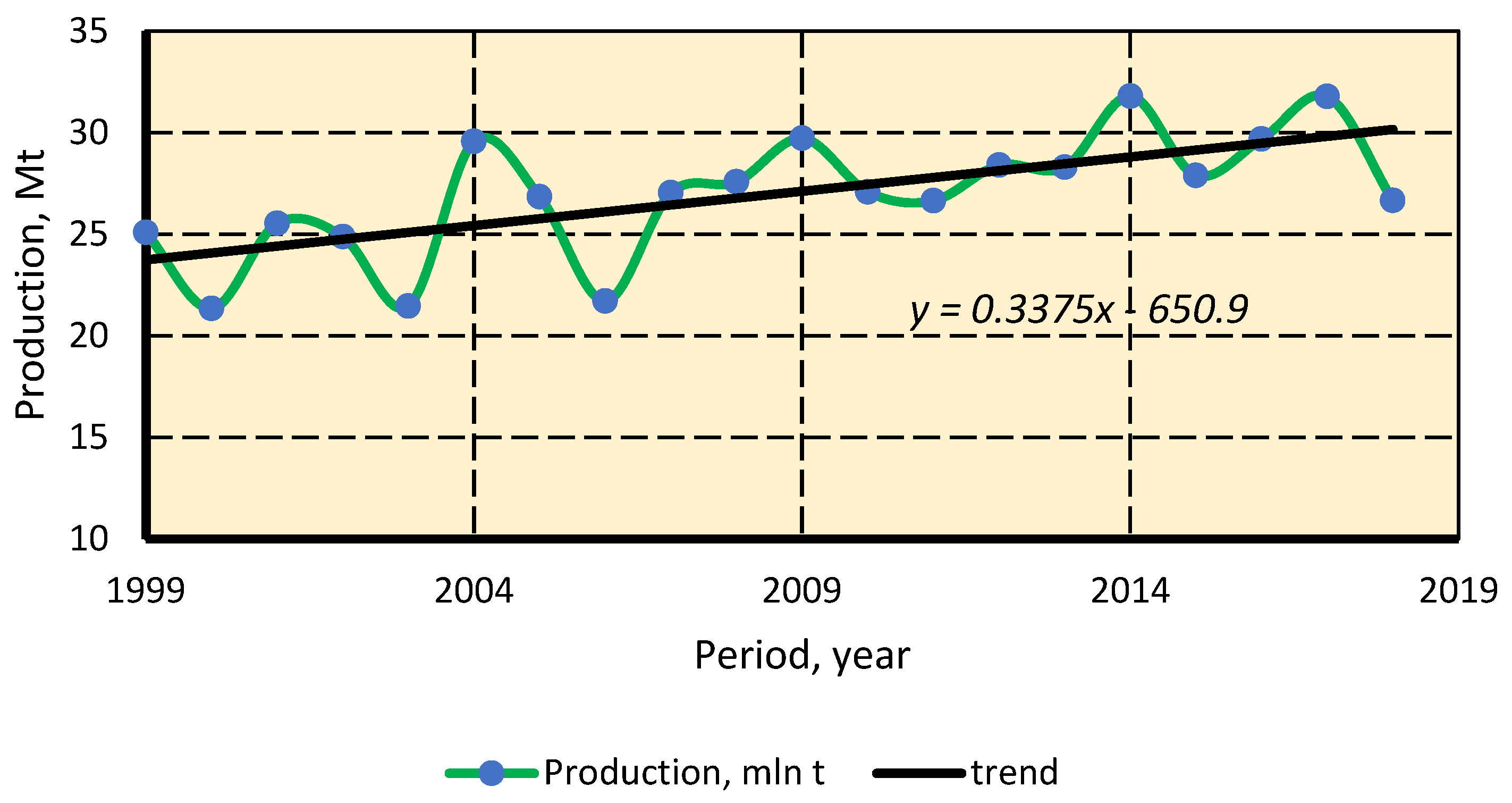
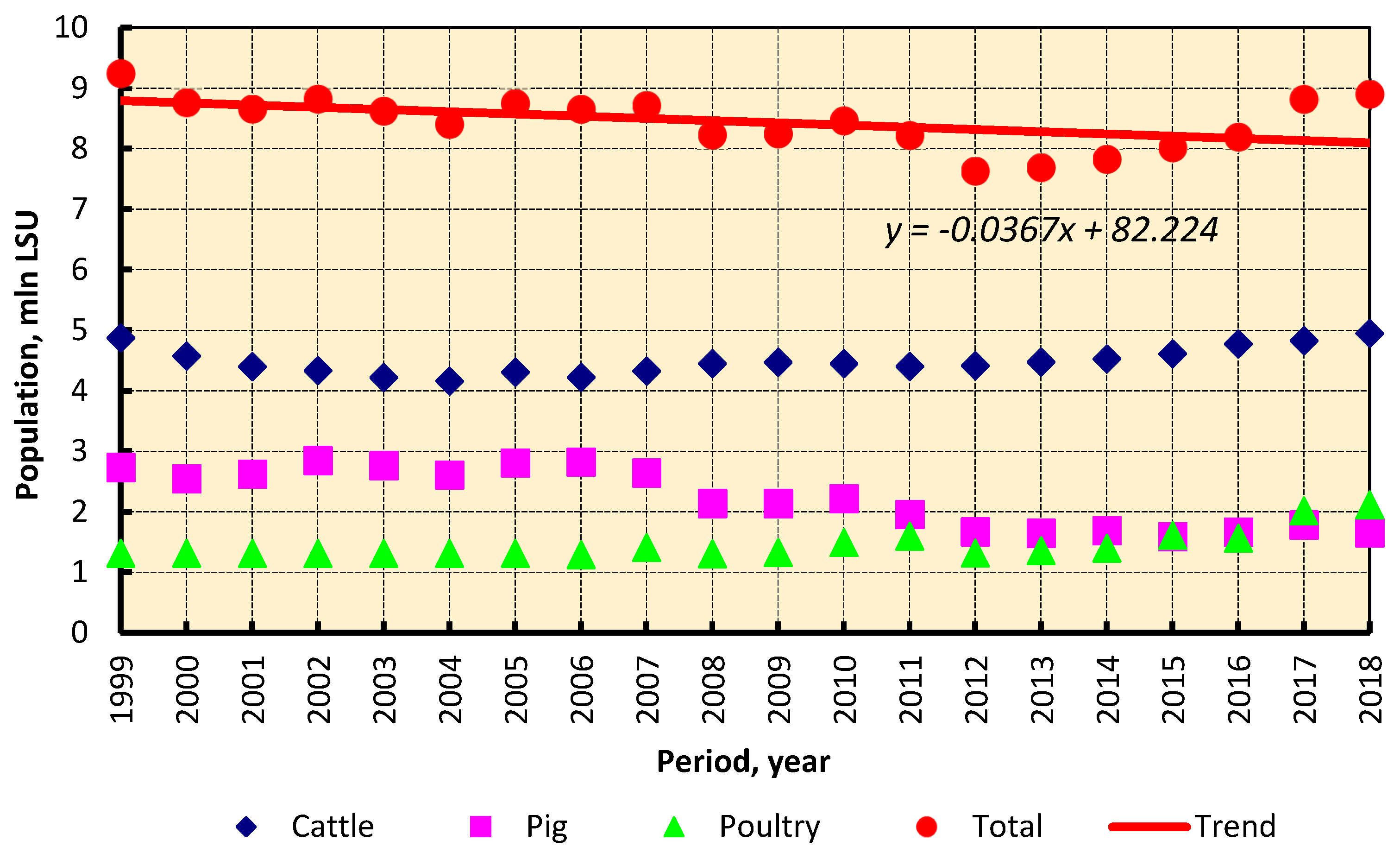
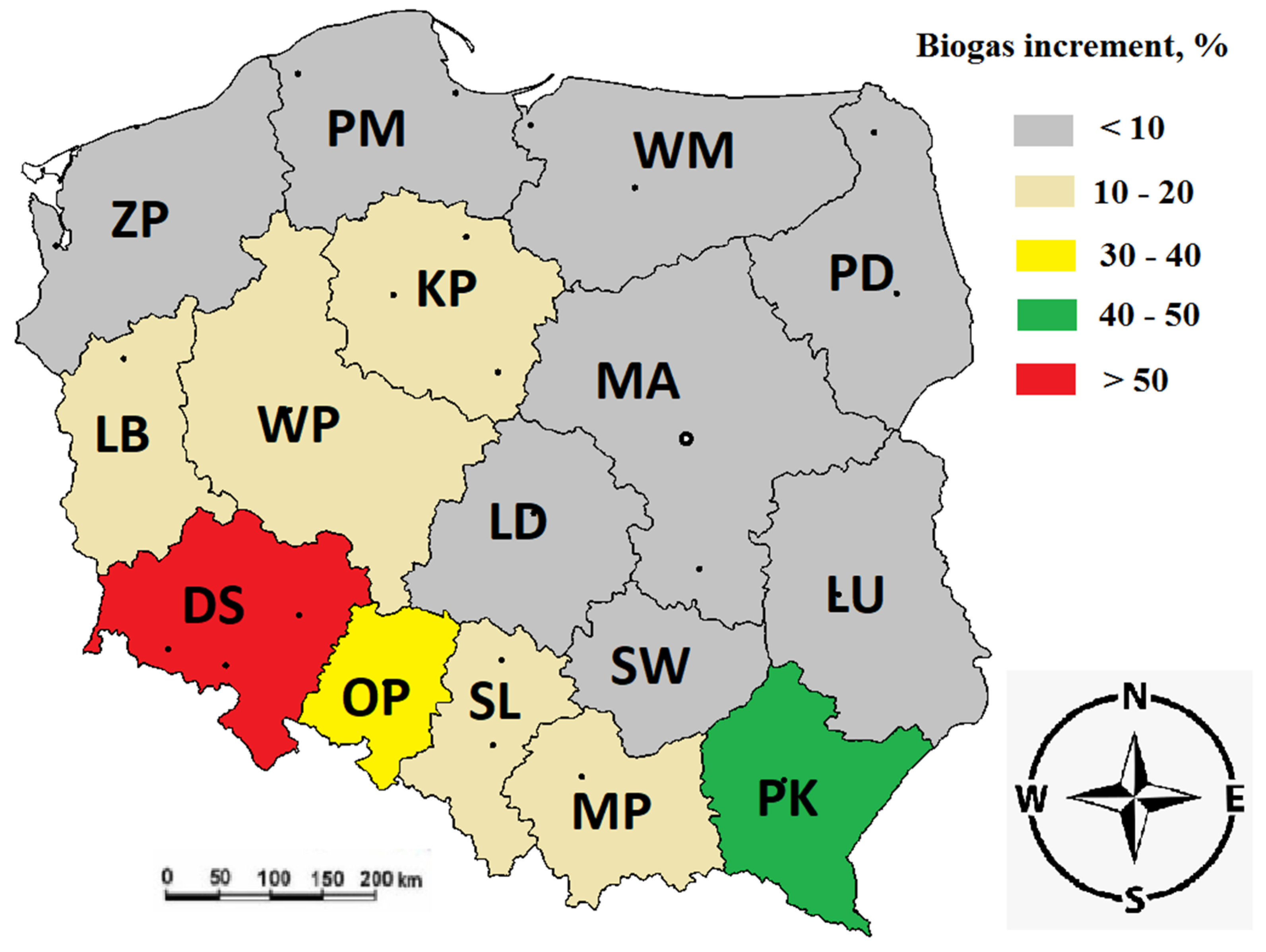


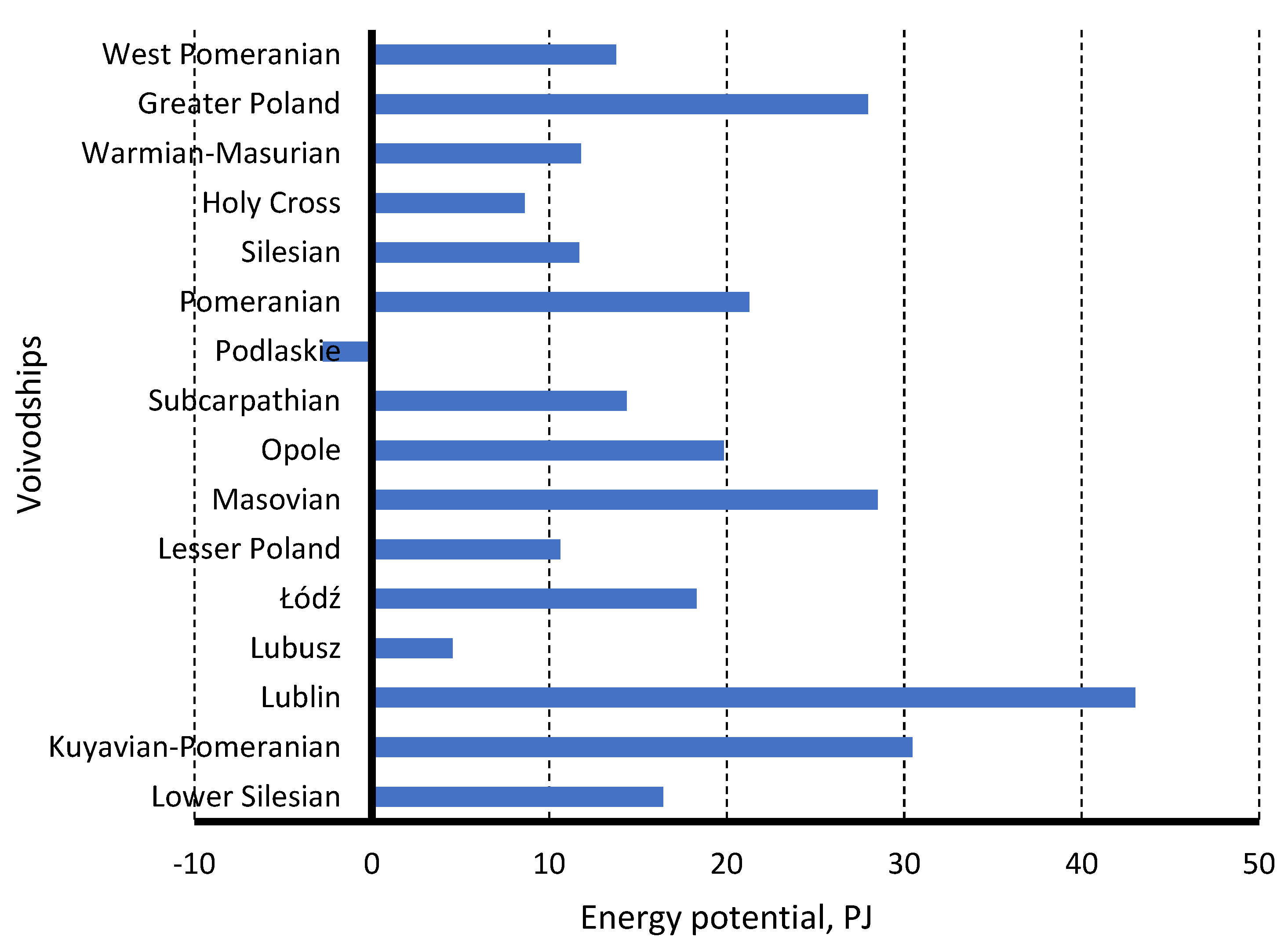
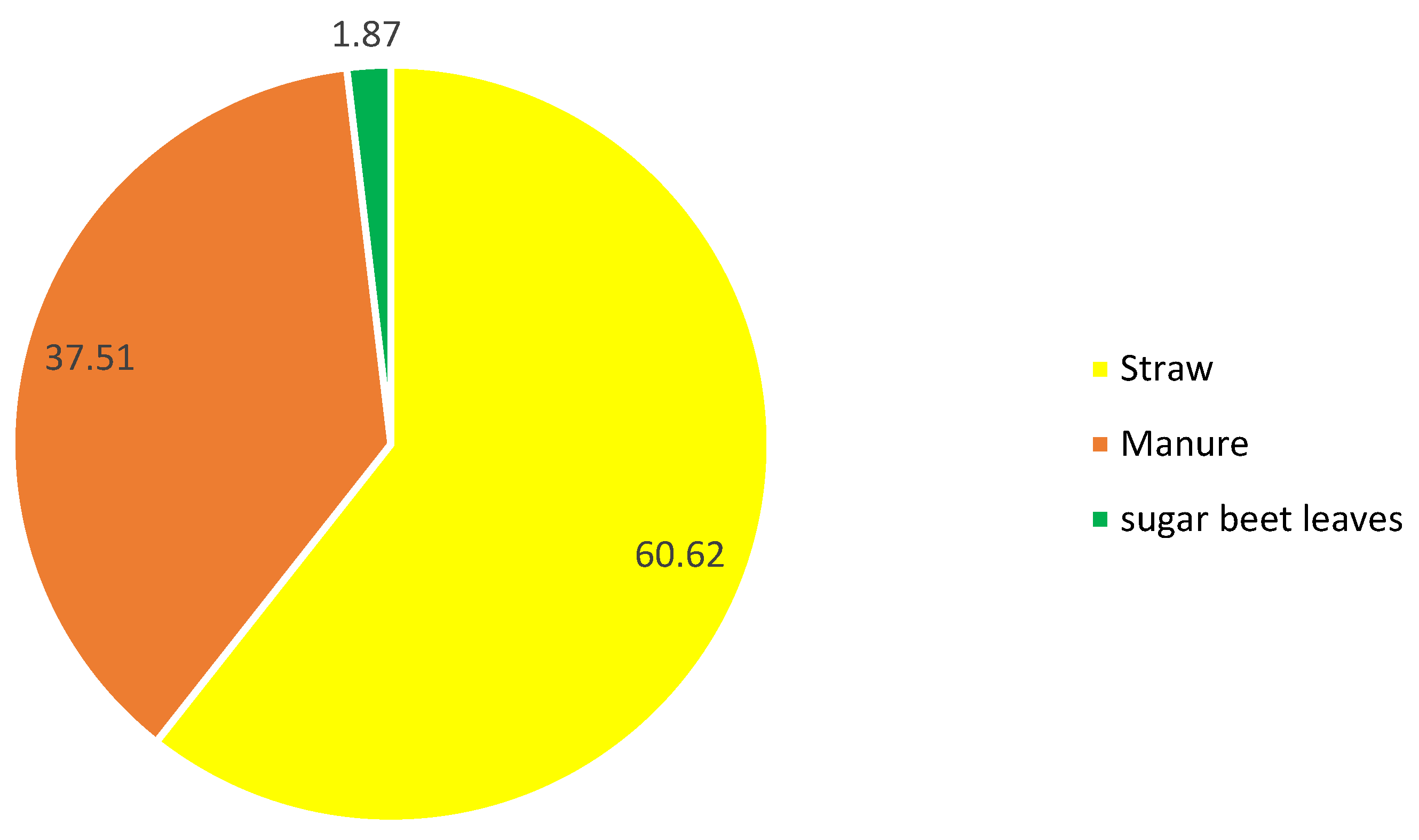
| Crop | Average | Maximum | Minimum |
|---|---|---|---|
| Wheat | 9.46 | 11.67 | 7.06 |
| Triticale | 4.03 | 5.34 | 1.90 |
| Rye | 3.16 | 4.86 | 2.01 |
| Cereals mixed for grain | 3.40 | 4.32 | 2.25 |
| Oats | 1.33 | 1.52 | 1.03 |
| Barley | 3.40 | 4.16 | 2.78 |
| Corn | 2.87 | 4.47 | 1.26 |
| Total | 27.05 | 31.79 | 21.34 |
| Group | Voivodship | Sum | Share of Biomass,% | Average | Minimum | Maximum |
|---|---|---|---|---|---|---|
| A | Lublin | 42.15 | - | 42.15 | 42.15 | 42.15 |
| B | Kuyavian-Pomeranian, Masovian, Greater Poland | 84.53 | - | 28.18 | 26.97 | 29.48 |
| C | Łódź, Opole, Pomeranian | 58.63 | - | 19.54 | 18.17 | 21.02 |
| D | Lower Silesian, Subcarpathian, West Pomeranian, Lesser Poland, Warmian-Masurian, Silesian, Holy Cross | 86.18 | - | 12.31 | 8.51 | 15.95 |
| E | Lubusz | 4.52 | - | 4.52 | 4.52 | 4.52 |
| F | Podlaskie | −2.77 | - | −2.77 | −2.77 | −2.77 |
| Total | 273.23 | 61.77 | 17.08 | −2.77 | 42.15 |
| Parameter | Unit | Hard Coal | Lignite |
|---|---|---|---|
| Initial data | |||
| Carbon dioxide emission factor | kg GJ−1 | 94.52 | 105.21 |
| Carbon dioxide emission factor associated with straw formation | kgCO2⋅GJ−1 | 12.1 | |
| Total annual consumption for power and heat production | PJ | 867.00 | 466.00 |
| Straw-based power generation | |||
| Volume of fossil fuel substituted by one ton of straw | t | 0.71 | 1.84 |
| Carbon dioxide emission reduced, kg per ton of straw | kg t−1 | 1417.80 | 1578.15 |
| Theoretical energy potential of straw | PJ | 168.78 | 168.78 |
| Theoretical share of fossil fuel substituted | % | 19.47 | 36.22 |
| Theoretical potential of carbon dioxide emission reduced | Mt year−1 | 13.91 | 15.72 |
| Biogas-based power generation | |||
| Volume of fossil fuel substituted by one 1000 cubic meters of biogas | t | 1.14 | 2.94 |
| Carbon dioxide emission reduced, kg per m3 of biogas | kg t −1 | 2268.48 | 2525.04 |
| Theoretical energy potential of biogas | PJ | 109.64 | 109.64 |
| Theoretical share of fossil fuel substituted | % | 12.65 | 23.53 |
| Theoretical potential of carbon dioxide emission reduced (power generation only) | Mt year−1 | 11.84 | 13.18 |
| Theoretical potential of carbon dioxide emission reduced (cogeneration) | Mt year−1 | 15.99 | 17.800 |
| Total straw and biogas | |||
| Theoretical energy potential | PJ | 278.42 | |
| Theoretical potential of carbon dioxide emission saving (biogas for power generation only) | Mt year−1 | 25.75 | 28.90 |
| Theoretical potential of carbon dioxide emission saving (biogas for cogeneration) | Mt year−1 | 29.90 | 33.52 |
Publisher’s Note: MDPI stays neutral with regard to jurisdictional claims in published maps and institutional affiliations. |
© 2021 by the authors. Licensee MDPI, Basel, Switzerland. This article is an open access article distributed under the terms and conditions of the Creative Commons Attribution (CC BY) license (https://creativecommons.org/licenses/by/4.0/).
Share and Cite
Havrysh, V.; Kalinichenko, A.; Brzozowska, A.; Stebila, J. Agricultural Residue Management for Sustainable Power Generation: The Poland Case Study. Appl. Sci. 2021, 11, 5907. https://doi.org/10.3390/app11135907
Havrysh V, Kalinichenko A, Brzozowska A, Stebila J. Agricultural Residue Management for Sustainable Power Generation: The Poland Case Study. Applied Sciences. 2021; 11(13):5907. https://doi.org/10.3390/app11135907
Chicago/Turabian StyleHavrysh, Valerii, Antonina Kalinichenko, Anna Brzozowska, and Jan Stebila. 2021. "Agricultural Residue Management for Sustainable Power Generation: The Poland Case Study" Applied Sciences 11, no. 13: 5907. https://doi.org/10.3390/app11135907






